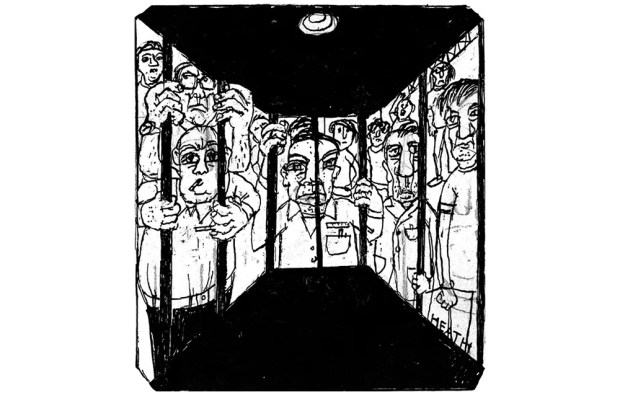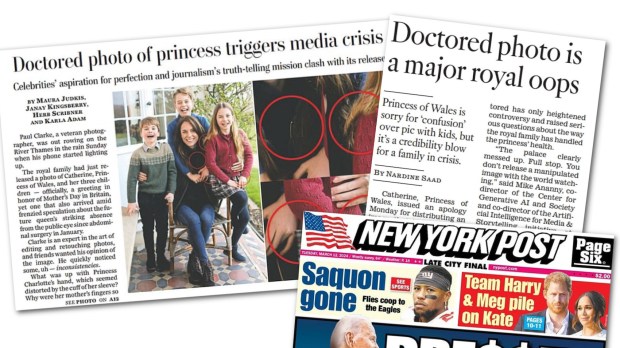For British taxpayers perturbed by their £6 million daily bill for housing asylum seekers in hotels, New York City mayor Eric Adams has the solution: handbills. Exasperated by a sudden influx he characterises as a ‘disaster’, Adams plans to dispense police-tape yellow flyers both at the city’s 188 sites for housing migrants and at America’s overrun, purely notional southern border. The leaflets warn in English and Spanish: ‘Since April 2022, over 90,000 migrants have come to New York City. There is no guarantee we will be able to provide shelter and services to new arrivals. Housing in NYC is very expensive. The cost of food, transportation, and other necessities is the highest in the United States. Please consider another city as you make your decision about where to settle in the US.’ Well, that’s one colossal headache sorted, then. Why didn’t anyone think of flyers before?
I’m reminded of being paid a pittance to distribute leaflets for a Little Richard concert in Atlanta in 1973 – a thankless task. Most pedestrians wouldn’t accept one. A few politely did, then immediately threw it away unread, often on the pavement; this was largely an exercise in secondary littering.
I had no idea that such modest slips of paper would prove the ingenious answer to a municipal crisis 50 years later. Why, now that the Big Apple is falling back on retro advertising tactics, let’s skywrite above the Rio Grande, ‘Don’t ♥ New York!’ Or maybe Adams should try his hand at radio jingles: ‘Other cities hit the spot. Ninety thousand, that’s a lot. Twice as much for a burger, too. Other cities are the place for you!’
Yet aside from exhibiting a certain, well, ineffectual quality, these leaflets are brandishing the high cost of necessities at a population that doesn’t plan on paying for them.
Now more than half occupied by new immigrants, NYC’s homeless shelters are bursting. Like Britain, the city has resorted to putting up foreign arrivals in hotels. One institution recently block-booked is the Roosevelt, a majestic four-star art deco landmark near Grand Central Station. This is where for three decades the bandleader Guy Lombardo welcomed in the New Year with ‘Auld Lang Syne’. ‘The rooms are outdated but they’re gorgeous,’ says a hotel security guard. ‘The migrants are going to think they landed in heaven. They’re never going to want to leave.’
Indeed, why leave? New York’s asylum seekers are provided with free health care, free NYC ID, help enrolling children in free public schools, free food, free legal counsel, as well as free accommodation in a city whose average rent for a two-bedroom flat is over $5,000 (£3,900) a month. Bike New York gives asylum seekers free bicycles.
Alas, these gratuities are not free for benefactors. The city is leasing each of the Roosevelt’s 1,025 rooms for 36 months at $200 a day, totalling $219,000 per room. For each migrant family, the average cost of emergency hotels is half as much again at $339 a day. The city expects to spend a budget-busting $4.3 billion on recent migrants, thanks to the five-and-a-half million-plus illegals who’ve crossed the US border during the Biden administration. Idiotically, NYC’s provision of shelter to anyone who shows up has been enshrined as a legal obligation. As a ‘sanctuary city’ that refuses to enforce federal immigration law, abstractly New York may deserve this fiscal nightmare, but its taxpayers do not.
The UK’s solution to its whopping hotel bill for migrants isn’t a flyer, you’ll be relieved to learn – but a barge. The Bibby Stockholm, which docked last week in Dorset, can house 500 migrants with en suite baths. The government boasts that asylum seekers will be provided with guided walks, trips to farms and sports events, festival excursions and biweekly English lessons.
In addition to three ‘culturally appropriate’ meals a day, migrants will enjoy a 24-hour food service. They’ll have full NHS access, as well as an on-board nurse and clinic, and be offered nearby allotments for cultivating vegetables and flowers. (Um – many Londoners wait years for an allotment.) The barge is kitted out with gyms, sports facilities (football, basketball, volleyball and netball), two TV rooms, five lounges, an IT room with laptop computers and free wifi, a courtyard with picnic tables, a multi-faith room, another room for ‘quiet reflection’, and a conference room bookable for meetings or hobbies. Residents are free to come and go, either on free hourly buses, or in a free taxi back if they miss the last bus home. They may be gone for up to a week at a time, but if migrants exceed this limit the management will ring up and ask if they’re OK.
A few tiny problems. One, in the three days before the Home Office’s proud announcement about its new luxury barge, 1,100 Channel migrants were apprehended: more than twice the boat’s capacity. Try over 100 barges. Two, money: the department is paying the NHS £1,900 per bed, Dorset council £3,500 per migrant plus a £380,000 block grant. Maybe the barge is cheaper than hotels, but all those laptops and 24-hour nachos add up. Three, if New York’s experience is any guide, the Bibby Stockholm won’t stay pristine for long. According to a former worker at the Row Hotel near Times Square – housing 5,000 migrants in 1,300 rooms, for which the city pays $500 each per night – officialdom’s hospitality is prone to being abused. The Row’s rooms are strewn with rubbish, drink, clothes, guns, drug paraphernalia and used condoms, their bins overflowing with free food that the residents don’t like.
Tiny problem number four: boiling popular rage. In both New York and Britain, comments after articles about the opulent Roosevelt hotel or the amenity-rich Bibby Stockholm explode with an apoplectic sense of injustice and betrayal. Besides, if this is deterrence, I’d love to see what come-hither looks like.
Got something to add? Join the discussion and comment below.
Get 10 issues for just $10
Subscribe to The Spectator Australia today for the next 10 magazine issues, plus full online access, for just $10.
You might disagree with half of it, but you’ll enjoy reading all of it. Try your first month for free, then just $2 a week for the remainder of your first year.















Comments
Don't miss out
Join the conversation with other Spectator Australia readers. Subscribe to leave a comment.
SUBSCRIBEAlready a subscriber? Log in